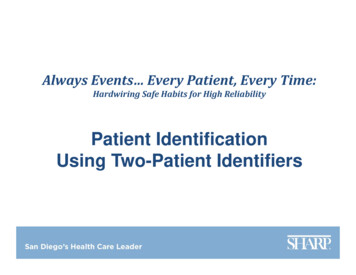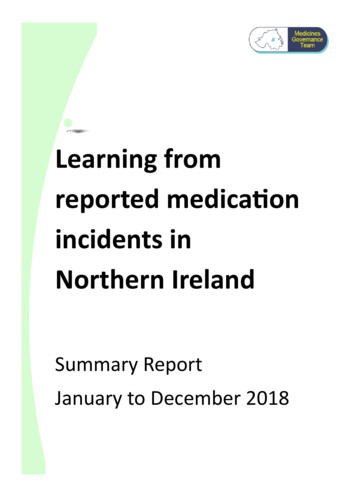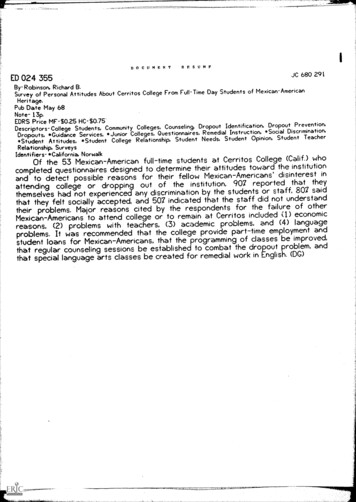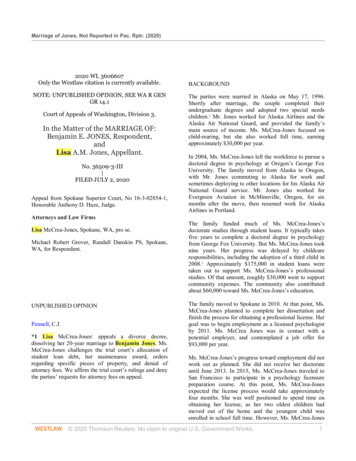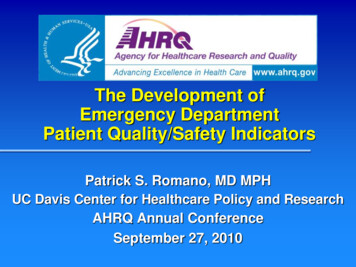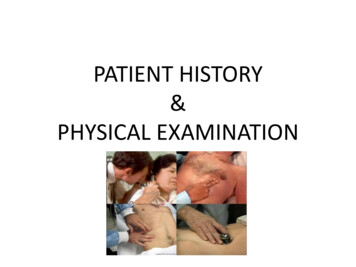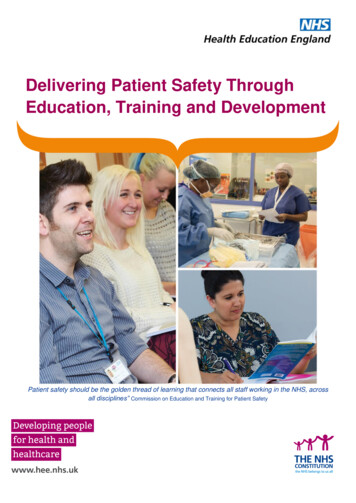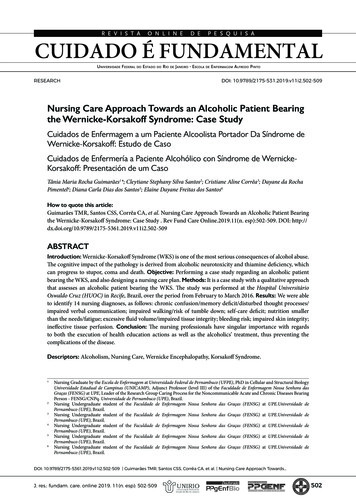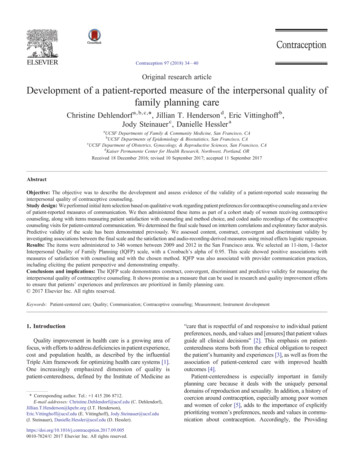
Transcription
Contraception 97 (2018) 34 – 40Original research articleDevelopment of a patient-reported measure of the interpersonal quality offamily planning careChristine Dehlendorf a, b, c,⁎, Jillian T. Henderson d , Eric Vittinghoff b ,Jody Steinauer c , Danielle Hessler aaUCSF Departments of Family & Community Medicine, San Francisco, CAbUCSF Departments of Epidemiology & Biostatistics, San Francisco, CAcUCSF Department of Obstetrics, Gynecology, & Reproductive Sciences, San Francisco, CAdKaiser Permanente Center for Health Research, Northwest, Portland, ORReceived 18 December 2016; revised 10 September 2017; accepted 11 September 2017AbstractObjective: The objective was to describe the development and assess evidence of the validity of a patient-reported scale measuring theinterpersonal quality of contraceptive counseling.Study design: We performed initial item selection based on qualitative work regarding patient preferences for contraceptive counseling and a reviewof patient-reported measures of communication. We then administered these items as part of a cohort study of women receiving contraceptivecounseling, along with items measuring patient satisfaction with counseling and method choice, and coded audio recordings of the contraceptivecounseling visits for patient-centered communication. We determined the final scale based on interitem correlations and exploratory factor analysis.Predictive validity of the scale has been demonstrated previously. We assessed content, construct, convergent and discriminant validity byinvestigating associations between the final scale and the satisfaction and audio-recording-derived measures using mixed effects logistic regression.Results: The items were administered to 346 women between 2009 and 2012 in the San Francisco area. We selected an 11-item, 1-factorInterpersonal Quality of Family Planning (IQFP) scale, with a Cronbach's alpha of 0.95. This scale showed positive associations withmeasures of satisfaction with counseling and with the chosen method. IQFP was also associated with provider communication practices,including eliciting the patient perspective and demonstrating empathy.Conclusions and implications: The IQFP scale demonstrates construct, convergent, discriminant and predictive validity for measuring theinterpersonal quality of contraceptive counseling. It shows promise as a measure that can be used in research and quality improvement effortsto ensure that patients' experiences and preferences are prioritized in family planning care. 2017 Elsevier Inc. All rights reserved.Keywords: Patient-centered care; Quality; Communication; Contraceptive counseling; Measurement; Instrument development1. IntroductionQuality improvement in health care is a growing area offocus, with efforts to address deficiencies in patient experience,cost and population health, as described by the influentialTriple Aim framework for optimizing health care systems [1].One increasingly emphasized dimension of quality ispatient-centeredness, defined by the Institute of Medicine as⁎ Corresponding author. Tel.: 1 415 206 8712.E-mail addresses: Christine.Dehlendorf@ucsf.edu (C. Dehlendorf),Jillian.T.Henderson@kpchr.org (J.T. Henderson),Eric.Vittinghoff@ucsf.edu (E. Vittinghoff), Jody.Steinauer@ucsf.edu(J. Steinauer), Danielle.Hessler@ucsf.edu (D. 017.09.0050010-7824/ 2017 Elsevier Inc. All rights reserved.“care that is respectful of and responsive to individual patientpreferences, needs, and values and [ensures] that patient valuesguide all clinical decisions” [2]. This emphasis on patientcenteredness stems both from the ethical obligation to respectthe patient's humanity and experiences [3], as well as from theassociation of patient-centered care with improved healthoutcomes [4].Patient-centeredness is especially important in familyplanning care because it deals with the uniquely personaldomains of reproduction and sexuality. In addition, a history ofcoercion around contraception, especially among poor womenand women of color [5], adds to the importance of explicitlyprioritizing women's preferences, needs and values in communication about contraception. Accordingly, the Providing
C. Dehlendorf et al. / Contraception 97 (2018) 34–40Quality Family Planning Services recommendations releasedin 2014 by the Centers for Disease Control and Preventionand Office of Population Affairs list client-centered care as oneof the main attributes of quality in the delivery of familyplanning care [6].While there are several dimensions to patient-centeredness,a core aspect is interpersonal communication between providerand patient. Measuring and providing feedback to providersabout the patient-centeredness of their communication areessential to research and quality improvement efforts aroundcontraceptive counseling [7]. To meet this need, we havedeveloped the Interpersonal Quality of Family Planning Care(IQFP) scale using a mixed-methods approach involvinginterviews with patients, observation of family planning visitsand scale development. This measure has previously beenfound to have predictive validity for method continuation [8].The purpose of this paper is to describe development of theinstrument and to report on other measures of its validity.2. Materials and methods2.1. Initial item selectionIn order to define the domains of interest for development ofthis measure, we first performed a qualitative study investigating women's preferences and experiences for contraceptivecounseling, informed by a systematic review investigatingquality of care in family planning [9] and other relevantliterature. This study used semistructured interviews withwomen of diverse race/ethnicities in order to understandaspects of care that align with women's own conceptions ofquality contraceptive counseling. We identified three domainsof relevance for women: interpersonal connection, receivingadequate information and decision support [10]. We thenperformed a review of patient-reported measures assessing theexperience of patient-centered care in health care generally toidentify constructs included in these measures [11–16], andmapped these on to the domains identified in our qualitativework to ensure that they were all represented. Drawing from boththese measures and content area-specific knowledge related tofamily planning, we then identified items corresponding toeach construct that was appropriate for the contraceptivecontext. For items related to quality interpersonal communication, these items were derived from the Consultation andRelationship Empathy (CARE) scale [16] and the Interpersonal Processes of Care (IPC) scale [11] (three items). As theIPC scale is designed to measure care over the past 12 months,these items were adapted to be visit specific, in collaborationwith the original developer of the IPC scale, Dr. Anita Stewart.Items related to decision support were again derived from theIPC scale (two items) as well as two items developed for thepurpose of this scale based on our qualitative work [10].Finally, for the information domain, items were derived fromthe IPC (two items) and the CARE scale (one item), in additionto two items that were developed for the purpose of this scale.This process identified 17 items. Consistent with the CARE35scale [16], which is also designed to be visit specific, ourresponse options were a 5-point Likert scale, ranging frompoor (1) to excellent (5).2.2. Study setting, design and data collectionWe conducted a longitudinal cohort study (the Patient–Provider Communication about Contraception study) in sixclinics in the San Francisco Bay Area in 2009–2012 with thegoal of investigating the relationship between contraceptivecounseling and contraceptive continuation, as well as exploringracial–ethnic differences in counseling, as previously described[8]. Briefly, women were eligible if they wished to discussstarting or changing a contraceptive method, were seeing aprovider participating in the study and spoke English. Inaddition, only white, black and Latina women were included, asthese were the only racial/ethnic groups with adequaterepresentation in the participating clinics for investigation ofdisparities. We approached patients at the time of their visit andassessed for eligibility and interest in participating. Aftercompleting written informed consent, those who enrolled in thestudy completed a previsit survey assessing their demographicsand a postvisit survey immediately following the visit abouttheir method choice and experience of care. Both surveys wereself-administered on paper. Patient's contraceptive counselingvisits were audio recorded, and patients were contacted forfollow-up by phone or email to assess method continuation at 3and 6 months.Providers also completed written informed consent. Datacollection from providers consisted of a one-time demographicsurvey following completion of data collection from patientparticipants. We linked patient and provider data through useof a provider identifier. All patients and providers receivedreimbursement for their time, and the UCSF InstitutionalReview Board approved the study.2.3. Identification of the IQFP scaleWe collected the 17 items assessing patient experience ofcare in the postvisit survey. To identify the final IQFP scale,statistical analysis included examination of the distribution andinteritem correlation of individual items. Among items thatwere highly intercorrelated (rN.80), we retained items based onconceptual grounds. We then used exploratory factor analysis(EFA) with promax rotation to identify relationships betweenitems and determine whether any could be removed orgrouped. Following standard techniques, interpretation wasbased upon eigenvalues (N1.0), scree plots and factor itemloadings (items loading N.60 on a given factor and b.40 on anyother factor). Based on the results of the EFA, we created asummary scale by summing the selected item responses.Missing responses on any individual IQFP items resulted in amissing total IQFP score. We assessed internal consistency ofthe total scale using Cronbach's α, as well as corrected item–total correlations. We dichotomized the resulting scores foranalysis based on both conceptual grounds — with a less thanperfect score being considered meaningfully different from a
36C. Dehlendorf et al. / Contraception 97 (2018) 34–40Fig. 1. Distribution of summed IQFP scores (range 11–55) (n 346).perfect score — and high negative skew of the distribution ofscores (Fig. 1). The use of a dichotomous score is consistentwith the commonly used Consumer Assessment of HealthcareProviders and Systems measures of patient experience [17].2.4. Validity testingWe assessed content validity, the extent to which a measurerepresents all areas or facets of a construct, based onrepresentation of all relevant domains and constructs fromprevious qualitative work on contraceptive counseling andconceptual understanding of patient-centered communication.We assessed construct validity, the degree to which ameasure assesses what it purports to measure, throughcomparison of IQFP scores with measures of global visitsatisfaction and satisfaction with the method selection processcollected from the postvisit survey. The choice of thesemeasures of validity was based on the fact that measures ofsatisfaction often correlate with measures of patient-centeredprocesses of care but are considered distinct [18]. Weconceptualized the IQFP as being more specific than measuresof satisfaction, as satisfaction measures tend to be informed byexpectation disconfirmation theory (i.e., the extent to which anexperience exceeded or fell below expectations [18,19]) andhave additional limitations of lack of differentiation and lack ofspecificity of measured behaviors [20]. In contrast, the items inthe IQFP assess the extent to which the patient experienced orperceived specific types of communication and exchangesconsistent with patient-centered care. To measure global visitsatisfaction, women were asked to rate their “overallsatisfaction with this visit to my health care provider” on a5-point Likert scale from excellent to poor; due to high levelsof negative skew with most respondents rating highsatisfaction (e.g., skewness statistic N1.5), the measure wasdichotomized to compare “excellent” responses (75%) to allothers. Satisfaction with the method selection process wasassessed using the question “How satisfied are you with thedecision making process about which birth control method youwill use?”, using a 7-point Likert scale. Patients completelysatisfied (53%) were compared to all others.Additional measures used to assess construct validityincluded satisfaction with method choice and the likelihood ofrecommending the provider to a friend. In both cases, ourhypothesis was that these measures would correlate positivelywith patient experience of care measured using the IQFP. Weassessed patient's immediate postvisit satisfaction with theirchosen method using a 7-point Likert scale ranging fromcompletely unsatisfied to completely satisfied, dichotomizedto compare completely/very satisfied (60%) to somewhatsatisfied, neutral and unsatisfied patients. Whether the patientwould recommend the provider to a friend was assessed withresponse options of “No, definitely not,” “No, I don't think so,”“Yes, I think so” and “Yes, definitely” and dichotomized bygrouping the “no” and “yes” responses [21].We evaluated convergent validity of the IQFP by assessingits association with clinician communication practices consistent with patient-centered care [8,22]. We assessed cliniciancommunication practices from audio recordings of visits usingmeasures derived from the Four Habits Coding Scheme(4HCS), a validated observational approach to assessingpatient-centered health communication [22], which wemodified slightly for the family planning context in collaboration with the original developer of the measure. The 4HCSconsists of four compon
Original research article Development of a patient-reported measure of the interpersonal quality of family planning care Christine Dehlendorfa,b,c,⁎, Jillian T. Hendersond, Eric Vittinghoffb, Jody Steinauerc, Danielle Hesslera aUCSF Departments of Family & Community Medicine, San Francisco, CA bUCSF Departments of Epidemiology & Biostatistics, San Francisco, CA

